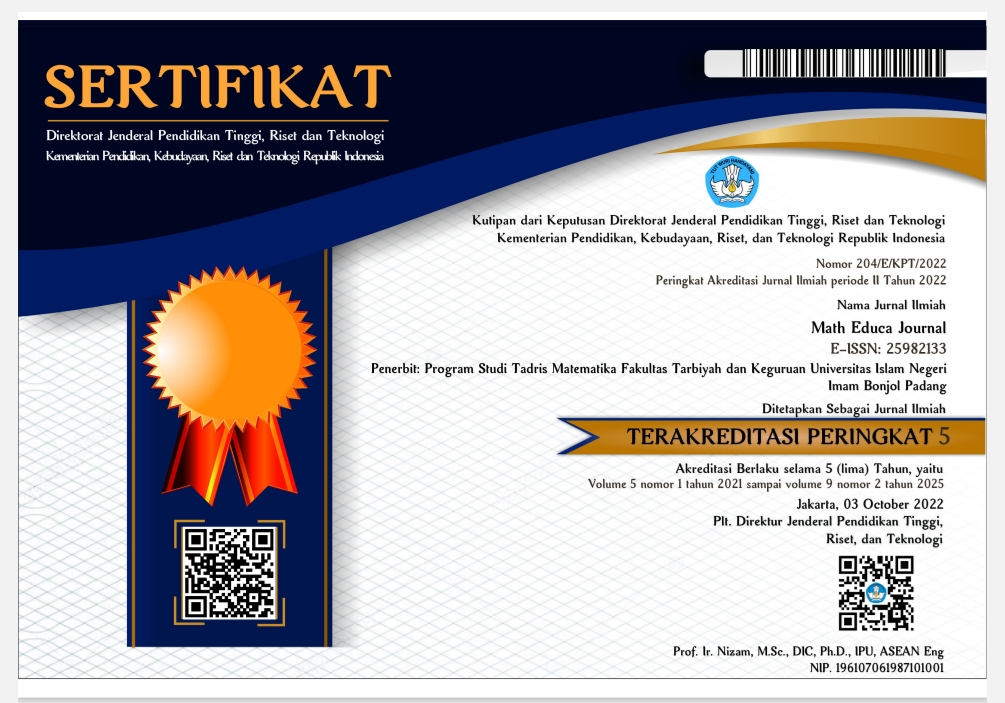Pengembangan Desain Pembelajaran Topik Rata-Rata Hitung Berbasis Realistic Mathematics Education (RME) di Kelas IX SMP/MTs
Abstract
Pleriminary research showed there were problems in arithmetic mean learning at junior high school grade IX . Students were more likely to be introduced by the use of formulas without involving the discovery of the concept itself and separate from the learning experience of students everyday. This research aimed to developing instructional design of mean topics arithmetic mean with Realistic Mathematics Education (RME) approach, for junior high school grade IX. This research that was combined Plomp and model Gravemeijer & Cobb develompment models, which consisted of three phases, there were the preliminary research (preparing for the experiment), a development phase ( prototyping phase/ design experiment) and the assessment phase (retrospective analysis). The subjects were students of grade IX MTsN Salido.This research develops an instructional design of the topic arithmetic mean using realisticmathematics education (RME) approach.The results of the experiment showed contexts teaching contained in the student books can stimulate students to develop their knowledge in finding statistical concepts. The whole strategy (emergent modeling) were found and discussed students, showing how the construction or the contribution of students in discovering the concept of arithmetics mean from the formal to the informal level. The results showed that the design of the learning topic arithmetic mean with RME approach is valid, practical and effective. Valid in terms of content and language. Practical in terms of practice, the ease and time required. Effective in terms of its potential impact on student’s mathematical reasoning abilities.
Keywords: Instructional Design, arithmetic mean, RME, Learning Trajectory, Design Research
Full Text:
PDFReferences
Bakker. 2004. Design Research in Statistics Education: On Symbolizing and Computer tools. Utrech: FreudenthalInstitute.
Gravemeijer, Koeno and Cobb, Paul. 2006. Design research from the Learning Design Perspective. Dalam Jan Ven Den Akker, et. al. Educational Design Research. London: Routledge
Groth. (2006). An Exploration of Students’ Statistika Thinking. Mathematics Education Research Journal.Volume 28.Number 1. 17-21
Hardiman, P. T., Well, A. D., &Pollatsek, A. (1984).Usefulness of balance model in understandingthe mean.Journal of Educational Psychology, 76(5), 792-801
Heuvel, Marja Van Den danPanhuizen. 2003. The Didactical Use of Models inRealistic Mathematics Education: an Example from A LongitudinalTrajectory on Percentage, (Online).(http://web.a.ebscohost.com/ehost/pdfviewer, diaksespadatanggal 26 April 2016)
NCTM (2000).Principles and standards for school mathematics. Reston, VA: National Councilof Teachers of Mathematics
Plomp, T dan N. Nieveen. (2013). Educational Design Research. Enshede: Netherlands Institute for Curriculum Development (SLO)
Simon, Martin A. 1995. Reconstructing Mathematics Pedagogy from a Conswtructive Perspective.Journal of Research in Mathematics Education.Vol. 26. No.2. 135-137. Diakses pada tanggal 20 April 2016
Suherman, Erman. 2003. Strategi Pembelajaran Matematika kontemporer. Bandung: FMIPA UPI
Tessmer, Martin. 1996. Planning and Conducting Formatif Evaluation. London: Kogan Page
Wilensky, U. (1997). What is normal anyway? Therapy for epistemological anxiety.EducationalStudies in Mathematics, 33, 171-202
Refbacks
- There are currently no refbacks.
The Journal Space of the Mathematics Education Department
Faculty of Education and Teacher Training
State Islamic University of Imam Bonjol Padang
Email: mej.uinibpadang@gmail.com

Math Educa Journal is licensed under a Lisensi Creative Commons Atribusi-NonKomersial 4.0 Internasional.
Based on a work at https://ejournal.uinib.ac.id/jurnal/index.php/matheduca.
All rights reserved p-ISSN: 2580-6726 | e-ISSN: 2598-2133




